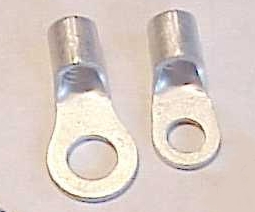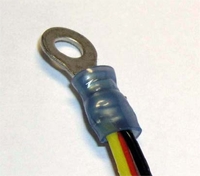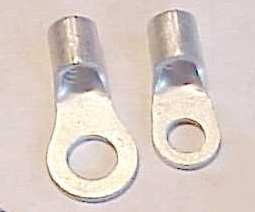 |
Matronics Email Lists
Web Forum Interface to the Matronics Email Lists
|
| View previous topic :: View next topic |
| Author |
Message |
jcappraiser(at)sbcglobal.
Guest
|
 Posted: Sun Mar 18, 2012 11:50 am Post subject: Aviation crimp terminals. Posted: Sun Mar 18, 2012 11:50 am Post subject: Aviation crimp terminals. |
 |
|
Having read the info on the AeroElectric site regarding aviation quality crimped terminals I feel I am much more informed as to their correct use & installation but I do have a couple of questions. It would seem that adding a small piece of a good quality shrink wrap, most likely clear, over the terminal & the first portion of the wire entering the terminal (in this case shielded) would add to the overall strength & stability of the double crimped assembly. My questions are: 1) Is this legal on a certificated aircraft? 2) Any compelling reason why this should not be done? Thanks for any replies. Johnny
[quote][b]
| | - The Matronics AeroElectric-List Email Forum - | | | Use the List Feature Navigator to browse the many List utilities available such as the Email Subscriptions page, Archive Search & Download, 7-Day Browse, Chat, FAQ, Photoshare, and much more:
http://www.matronics.com/Navigator?AeroElectric-List |
|
|
|
| Back to top |
|
 |
jay(at)horriblehyde.com
Guest
|
 Posted: Sun Mar 18, 2012 12:43 pm Post subject: Aviation crimp terminals. Posted: Sun Mar 18, 2012 12:43 pm Post subject: Aviation crimp terminals. |
 |
|
Johnny,
It’s a very good idea to do that- however, there are times that it is not required. The shrink wrap (by which I think you mean heat shrink), properly applied, provides a great stress reliever to the wire/ crimp joint. Generally I apply three layers of heat shrink- a long thin one first and then two successively thicker ones, where the last layer goes over the insulation of the crimp and then onto the two layers on the wire, so that there are graduated layers of material that absorb vibration and provide stress relief. I do this in areas where the wire does not immediately go into a bundle that will support it from vibration.
Where you have a wire that can immediately be supported you do not need this stress relief.
Jay
From: owner-aeroelectric-list-server(at)matronics.com [mailto:owner-aeroelectric-list-server(at)matronics.com] On Behalf Of John Cammarano
Sent: 18 March 2012 09:45 PM
To: aeroelectric-list(at)matronics.com
Subject: Aviation crimp terminals.
Having read the info on the AeroElectric site regarding aviation quality crimped terminals I feel I am much more informed as to their correct use & installation but I do have a couple of questions. It would seem that adding a small piece of a good quality shrink wrap, most likely clear, over the terminal & the first portion of the wire entering the terminal (in this case shielded) would add to the overall strength & stability of the double crimped assembly. My questions are: 1) Is this legal on a certificated aircraft? 2) Any compelling reason why this should not be done? Thanks for any replies. Johnny
| Quote: | | http://www.matronics.com/Navigator?AeroElectric-List |
01234567
[quote][b]
| | - The Matronics AeroElectric-List Email Forum - | | | Use the List Feature Navigator to browse the many List utilities available such as the Email Subscriptions page, Archive Search & Download, 7-Day Browse, Chat, FAQ, Photoshare, and much more:
http://www.matronics.com/Navigator?AeroElectric-List |
|
|
|
| Back to top |
|
 |
nuckolls.bob(at)aeroelect
Guest
|
 Posted: Sun Mar 18, 2012 1:00 pm Post subject: Aviation crimp terminals. Posted: Sun Mar 18, 2012 1:00 pm Post subject: Aviation crimp terminals. |
 |
|
At 02:45 PM 3/18/2012, you wrote:
Having read the info on the AeroElectric site regarding aviation
quality crimped terminals I feel I am much more informed as to their
correct use & installation but I do have a couple of questions.
It would seem that adding a small piece of a good quality shrink
wrap, most likely clear, over the terminal & the first portion of the
wire entering the terminal (in this case shielded) would add to the
overall strength & stability of the double crimped assembly.
Where do you perceive a 'weakness'?
My questions are:
1) Is this legal on a certificated aircraft?
I've never seen it done . . . I'm not aware of
any prohibition either. But anyone with much experience
in aviation would ask you the same question I
posed above.
2) Any compelling reason why this should not be done?
Adds weight, time, cost of materials and bulk to
a wire termination without demonstrable benefit.
Bob . . .
| | - The Matronics AeroElectric-List Email Forum - | | | Use the List Feature Navigator to browse the many List utilities available such as the Email Subscriptions page, Archive Search & Download, 7-Day Browse, Chat, FAQ, Photoshare, and much more:
http://www.matronics.com/Navigator?AeroElectric-List |
|
|
|
| Back to top |
|
 |
nuckolls.bob(at)aeroelect
Guest
|
 Posted: Mon Mar 19, 2012 6:15 am Post subject: Aviation crimp terminals. Posted: Mon Mar 19, 2012 6:15 am Post subject: Aviation crimp terminals. |
 |
|
At 03:42 PM 3/18/2012, you wrote:
Johnny,
Itís a very good idea to do that- however, there are times that it is not required. The shrink wrap (by which I think you mean heat shrink), properly applied, provides a great stress reliever to the wire/crimp joint. Generally I apply three layers of heat shrink- a long thin one first and then two successively thicker ones, where the last layer goes over the insulation of the crimp and then onto the two layers on the wire, so that there are graduated layers of material that absorb vibration and provide stress relief. I do this in areas where the wire does not immediately go into a bundle that will support it from vibration.
Where you have a wire that can immediately be supported you do not need this stress relief.
It's important to make a distinction here between what
has been euphemistically called 'aviation' terminals
[img]cid:.0[/img]
. . . like the AMP Pre-Insulated Diamond Grip or PIDG
terminal above and 'those other' terminals like . . .
[img]cid:.1[/img]
The PIDG terminal is a one-stop solution to wire
termination that provides both gas-tight electrical
connection between metals of terminal and wire
PLUS mechanical support immediately adjacent to
the point were the wire strands exit the crimped
connection. This is described in the article
at . . .
http://aeroelectric.com/articles/terminal.pdf
Those 'other' terminals can be applied with
equal quality crimps but they are not fitted
with the extra pieces of metal and plastic
that provides support. This style of terminal
is generally found in the few places on the
airplane where FAT wires get bolted to typically
larger, terminal studs. One methodology for
using these terminals on the OBAM aircraft
is illustrated here . . .
http://aeroelectric.com/articles/AlumWire/AlumWire.html
and here . . .
http://aeroelectric.com/articles/big_term.pdf
Interestingly enough, FAT wire strands are not so
prone to failure due to flexing of at the
crimp/solder joint. I've seen some fat wire
terminal failures at where the terminal flag
broke off between the stud and the connector
barrel. The wires are often stiffer than the
terminal that attaches them! So it's a good
idea not to cantilever long runs of FAT wire
off the stud on say alternator b-leads and
starters.
One can finish of the installation of such
terminals by covering the barrel and wire
junction with heat shrink . . . or even the
heavier, double-walled stuff. In the grand
scheme of things, mechanical benefits to the
termination are minimal. But it DOES look
nicer.
The point to be made here is that adding
any sort of mechanical support to a wire
terminated with a PIDG style device is unnecessary.
The 'aviation' terminals are the gold-standard
for wire termination in all venues that
demand the-best-we-know-how-to-do of which
airplanes is a small segment. Adding shrink
to a soldered or crimped FAT wire termination
is more cosmetic than useful.
In the earliest editions of the 'Connection
I suggested that a builder could use solder-
on terminals common to the electronics industry.
[img]cid:.2[/img]
Here the termination WILL indeed benefit from an
addition of heat-shrink. But in the grand
scheme of things, even the most frugal
builder will find that the savings in labor
and materials for solder+shrink on small
wires is probably more than offset by buying
the-best-we-know-how-do-to terminals and
installing them with the appropriate tool.
Go PIDG where you can for 22-10AWG wires. Then
accomplish due consideration for support
of FAT wires on engines where useful support
is offered by the terminal PLUS some mechanical
feature adjacent to the point where the terminal
drops onto a stud. Using super-flex wire (like
welding cable) on batteries is a prophylactic
against vibration induced stresses on the battery's
typically small attach bolts and/or lead connection
tabs.
Bob . . .
| | - The Matronics AeroElectric-List Email Forum - | | | Use the List Feature Navigator to browse the many List utilities available such as the Email Subscriptions page, Archive Search & Download, 7-Day Browse, Chat, FAQ, Photoshare, and much more:
http://www.matronics.com/Navigator?AeroElectric-List |
|
| Description: |
|
| Filesize: |
22.38 KB |
| Viewed: |
2507 Time(s) |

|
| Description: |
|
| Filesize: |
31.83 KB |
| Viewed: |
2507 Time(s) |

|
| Description: |
|
| Filesize: |
3.38 KB |
| Viewed: |
2507 Time(s) |

|
|
|
| Back to top |
|
 |
jcappraiser(at)sbcglobal.
Guest
|
 Posted: Mon Mar 19, 2012 2:51 pm Post subject: Aviation crimp terminals. Posted: Mon Mar 19, 2012 2:51 pm Post subject: Aviation crimp terminals. |
 |
|
Thanks Bob - Great helpful info as usual.
Johnny
From: Robert L. Nuckolls, III (nuckolls.bob(at)aeroelectric.com)
Sent: Monday, March 19, 2012 7:14 AM
To: aeroelectric-list(at)matronics.com (aeroelectric-list(at)matronics.com)
Subject: RE: Aviation crimp terminals.
At 03:42 PM 3/18/2012, you wrote:
Johnny,
Itís a very good idea to do that- however, there are times that it is not required. The shrink wrap (by which I think you mean heat shrink), properly applied, provides a great stress reliever to the wire/crimp joint. Generally I apply three layers of heat shrink- a long thin one first and then two successively thicker ones, where the last layer goes over the insulation of the crimp and then onto the two layers on the wire, so that there are graduated layers of material that absorb vibration and provide stress relief. I do this in areas where the wire does not immediately go into a bundle that will support it from vibration.
Where you have a wire that can immediately be supported you do not need this stress relief.
It's important to make a distinction here between what
has been euphemistically called 'aviation' terminals
[img]cid:7B78785235A94D6E977064660772B377(at)JohnnyPC[/img]
. . . like the AMP Pre-Insulated Diamond Grip or PIDG
terminal above and 'those other' terminals like . . .
[img]cid:B464404F536843CA9C559A12415D3CE2(at)JohnnyPC[/img]
The PIDG terminal is a one-stop solution to wire
termination that provides both gas-tight electrical
connection between metals of terminal and wire
PLUS mechanical support immediately adjacent to
the point were the wire strands exit the crimped
connection. This is described in the article
at . . .
http://aeroelectric.com/articles/terminal.pdf
Those 'other' terminals can be applied with
equal quality crimps but they are not fitted
with the extra pieces of metal and plastic
that provides support. This style of terminal
is generally found in the few places on the
airplane where FAT wires get bolted to typically
larger, terminal studs. One methodology for
using these terminals on the OBAM aircraft
is illustrated here . . .
http://aeroelectric.com/articles/AlumWire/AlumWire.html
and here . . .
http://aeroelectric.com/articles/big_term.pdf
Interestingly enough, FAT wire strands are not so
prone to failure due to flexing of at the
crimp/solder joint. I've seen some fat wire
terminal failures at where the terminal flag
broke off between the stud and the connector
barrel. The wires are often stiffer than the
terminal that attaches them! So it's a good
idea not to cantilever long runs of FAT wire
off the stud on say alternator b-leads and
starters.
One can finish of the installation of such
terminals by covering the barrel and wire
junction with heat shrink . . . or even the
heavier, double-walled stuff. In the grand
scheme of things, mechanical benefits to the
termination are minimal. But it DOES look
nicer.
The point to be made here is that adding
any sort of mechanical support to a wire
terminated with a PIDG style device is unnecessary.
The 'aviation' terminals are the gold-standard
for wire termination in all venues that
demand the-best-we-know-how-to-do of which
airplanes is a small segment. Adding shrink
to a soldered or crimped FAT wire termination
is more cosmetic than useful.
In the earliest editions of the 'Connection
I suggested that a builder could use solder-
on terminals common to the electronics industry.
[img]cid:C0D476B8E3DA44D881AFCFB73D0B2A91(at)JohnnyPC[/img]
Here the termination WILL indeed benefit from an
addition of heat-shrink. But in the grand
scheme of things, even the most frugal
builder will find that the savings in labor
and materials for solder+shrink on small
wires is probably more than offset by buying
the-best-we-know-how-do-to terminals and
installing them with the appropriate tool.
Go PIDG where you can for 22-10AWG wires. Then
accomplish due consideration for support
of FAT wires on engines where useful support
is offered by the terminal PLUS some mechanical
feature adjacent to the point where the terminal
drops onto a stud. Using super-flex wire (like
welding cable) on batteries is a prophylactic
against vibration induced stresses on the battery's
typically small attach bolts and/or lead connection
tabs.
Bob . . .
| | - The Matronics AeroElectric-List Email Forum - | | | Use the List Feature Navigator to browse the many List utilities available such as the Email Subscriptions page, Archive Search & Download, 7-Day Browse, Chat, FAQ, Photoshare, and much more:
http://www.matronics.com/Navigator?AeroElectric-List |
|
| Description: |
|
| Filesize: |
22.38 KB |
| Viewed: |
2501 Time(s) |

|
| Description: |
|
| Filesize: |
31.83 KB |
| Viewed: |
2501 Time(s) |

|
| Description: |
|
| Filesize: |
3.38 KB |
| Viewed: |
2501 Time(s) |

|
|
|
| Back to top |
|
 |
|
|
You cannot post new topics in this forum
You cannot reply to topics in this forum
You cannot edit your posts in this forum
You cannot delete your posts in this forum
You cannot vote in polls in this forum
You cannot attach files in this forum
You can download files in this forum
|
Powered by phpBB © 2001, 2005 phpBB Group
|








